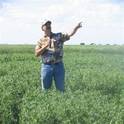
The use of cover crops can decrease soil erosion, weed density, and nitrate leaching while improving soil quality. We investigated nine cover crops, winter rye (Secale cereale L.), winter triticale (× Triticosecale Wittm. ex A. Camus), two winter canola (Brassica napus L.), winter camelina [Camelina sativa (L.) Crantz], spring barley (Hordeum vulgare L.), spring oat (Avena sativa L.), turnip (B. rapa L.), and hairy vetch (Vicia villosa Roth), as sole crops and selected binary and trinary mixtures and their influences on subsequent corn (Zea mays L.) productivity. A control treatment of no cover crop was included. Cover crops were no-till drilled immediately after soybean [Glycine max (L.) Merr] harvest. The study was a randomized complete block conducted in five environments over 2013–2014 and 2014–2015. Across environments, rye and rye mixtures produced the greatest spring aboveground biomass (758 kg ha–1), C, and N accumulation, had some of the lowest spring soil nitrate concentrations, and generally produced the lowest corn leaf chlorophyll. Rye accounted for more than 79% of spring aboveground biomass accumulation in rye mixtures. Triticale and camelina monoculture produced approximately 50% less biomass than rye or mixtures with rye. Cover crops in monoculture and mixtures did not influence surface soil temperature, soil P or K concentrations, weed density, weed community, or corn yield. Cover crops had limited influence on volumetric soil water content. Cover crop mixtures had no advantages over monocultures except for increasing fall stand density. Turnip and vetch had limited winter survival while barley, oat, and canola winterkilled.
Available at: http://works.bepress.com/andrew_lenssen/133/

This article is published as Appelgate, Seth R., Andrew W. Lenssen, Mary H. Wiedenhoeft, and Thomas C. Kaspar. "Cover Crop Options and Mixes for Upper Midwest Corn–Soybean Systems." Agronomy Journal 109, no. 3 (2017): 968-984. doi: 10.2134/agronj2016.08.0453.